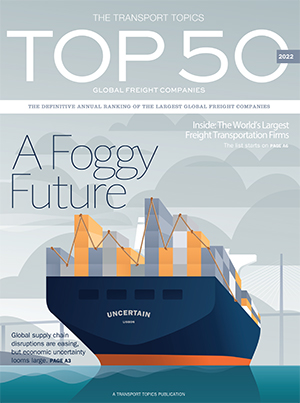Special to Transport Topics
A Clouded Outlook for Global Freight
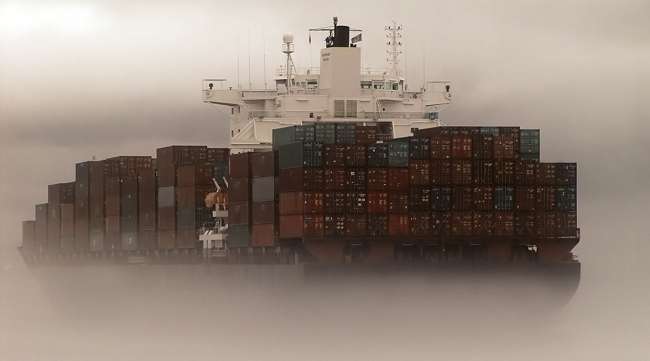
[Stay on top of transportation news: Get TTNews in your inbox.]
Describing global supply chains as “volatile” for the last two years is an understatement. Bottlenecks, inventory imbalances and soaring costs contributed to industries and consumers worldwide experiencing negative ripple effects.
Glimmers of hope are emerging, but anxiety grows over whether freight volumes can maintain traction amid high inflation and economic uncertainty.
Supply chain disruptions are not over, but they’re easing, resulting in “things moving more fluidly and generally at a lower cost,” said Tim Denoyer, vice president and senior analyst at ACT Research.
Ocean shipping, a leading indicator of global conditions, is “a much different market this year than what we saw the last two years,” Denoyer said.
Shipping costs are pulling back from their historic highs and spot rates for ocean containers dropped 61% year-over-year, according to Freightos Baltic Index data for the week ending Sept. 23. Slowing demand in the U.S. freed up capacity and loosened the tight market.
“The amount of cargo at sea to the U.S. is 30% lower compared to 2021,” and “the spike in freight rates of 2021 is stabilizing due to slow demand,” said Gopal R, global leader at Frost & Sullivan’s supply chain and logistics practice.
The severe backlogs that plagued West Coast ports and stranded billions of dollars of goods for much of 2020 and 2021 are clearing.
“We have substantially mitigated the bottlenecks that we were experiencing earlier,” said Mario Cordero, executive director at the Port of Long Beach, the nation’s second busiest port. “Back in January of this year, we had about 109 vessels waiting to get into the Port of Long Beach or the Port of Los Angeles. That number now is in the single digits.”
He credits three main factors: the White House appointing an envoy last fall to bring together logistics players and address supply chain issues; implementing “pop-up ports” at inland yards for excess container storage; and extending hours of operation. The San Pedro Bay ports also proposed carrier dwell fees for each train- or truck-bound container that remained at the port for nine days or more, although no fee has been levied to date because of continued positive results.
“I’m not declaring complete normalization. However, we’re on the road to a semblance of normalization,” Cordero said.
Some of the problems have shifted to East Coast ports, though, as companies divert their freight. The Port of Savannah in Georgia is working through a containership backlog and reported a downward trend in water-based imports as of August that it expected to continue at least into the fall. Still, Savannah’s port has experienced significant growth. The Georgia Ports Authority reports that it had its busiest month ever in August and handled 575,513 20-foot-equivalent container units, an 18.5% year-over-year increase.
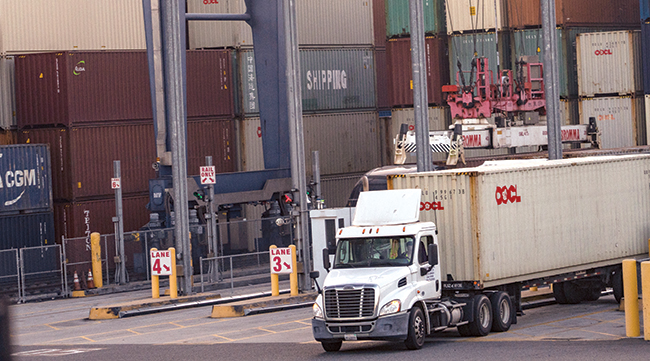
West Coast ports have been clearing the severe container backlogs that hindered freight flows for much of the past two years. (Damian Dovarganes/Associated Press)
The Port of New York and New Jersey marked 25 consecutive months of growth in August. That month it was the busiest U.S. port by processing 843,191 20-foot-equivalent units, or TEUs, more than the Port of Los Angeles’ 805,314 TEUs and Port of Long Beach’s 806,940 TEUs.
An ongoing labor dispute and fears of a strike at 29 West Coast ports further fuel the volume shift to East Coast ports.
“Despite the fact that we have these contemporaneous labor negotiations here on the West Coast, I think the important thing that we need to note is that the cargo has kept moving,” Cordero said.
Now, analysts are monitoring whether the efficiency improvements will help West Coast ports regain market share or if some volume will permanently remain on the East Coast, regardless of the longer cargo journeys and higher costs for shipping there via the Panama Canal.
Trucking and Rail
The geographical shift in container port traffic affects rail and trucking companies as well. Those primarily serving the West Coast generally saw their volumes drop this year, and vice versa on the East Coast.
Changing consumer buying patterns have thrown off international supply chains, creating inventory imbalances. The changes are also causing different demand patterns for transporters. Another consumer purchasing shift currently is occurring as consumers return to spending on services instead of goods. This post-pandemic market renormalization is contributing to softening transport demand.
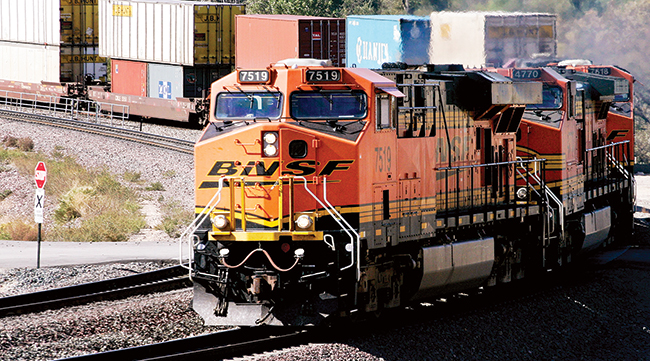
Ongoing labor negotiations have some fearing a U.S. freight rail strike and another major supply chain disruption. (Jonathan Alcorn/Bloomberg News)
Some retailers are still receiving products they ordered long ago and experiencing overstocks, while other products like semiconductors remain in short supply, said American Trucking Associations Chief Economist Bob Costello. Many retailers resorted to summer discounting to liquidate inventories, which spurred an uptick in trucking volumes.
“Supplier delivery times remain lengthy, and it is still uncertain when capacity constraints, including landside bottlenecks in trucking and warehousing, could impact” global container demand, said Frost & Sullivan’s Gopal R.
Trucking volumes rose overall in 2022. In August, the Cass Freight Index was up 3.6% year-over-year and 6.6% month-over-month.
While “2021 was just a banner year for trucking overall,” the contract and spot markets bifurcated in 2022, Costello said. Transport demand was so high during the pandemic that contract carriers couldn’t haul it all, so shippers seeking capacity relied heavily on the spot market to fill gaps. Consequently, spot rates surged, but that portion of the freight market has since cooled.
Carriers dependent on spot freight face challenges as rates have fallen sharply from early pandemic surges. DAT Freight & Analytics showed a 43.8% year-over-year drop in spot loads in August. Analysts expect further spot challenges, at least in the short term, whereas contract carriers are likely to end 2022 on a better note as their shippers return and markets rebalance.

Costello
“There’s way too many people that are over-reading the tea leaves on the spot market and implying that it’s a problem across the entire trucking industry; I do not believe that,” Costello said. “What’s happening is we’re getting back to pre-pandemic [levels] between contract and spot market freight.”
Freight has softened a bit in recent months. Although contract isn’t necessarily growing at the same pace as earlier in 2022, “it’s not plummeting like the spot market. ... And I really don’t expect it to, either,” Costello said.
Pent-up demand still exists for certain products affected by earlier shortages, including passenger auto and commercial truck production stunted by the semiconductor shortage. “But as we go into a much rougher economic environment, the question is, ‘How resilient is that pent-up demand, or might it just not exist next year?’” Denoyer said.
Next year, “it’s definitely a good outlook for shippers” in terms of smoother cargo movement and lower transport rates, he said. “But the asset owners who have been in the catbird seat the last couple years are going to have a tougher year next year.”
Speed Bumps or Roadblocks?
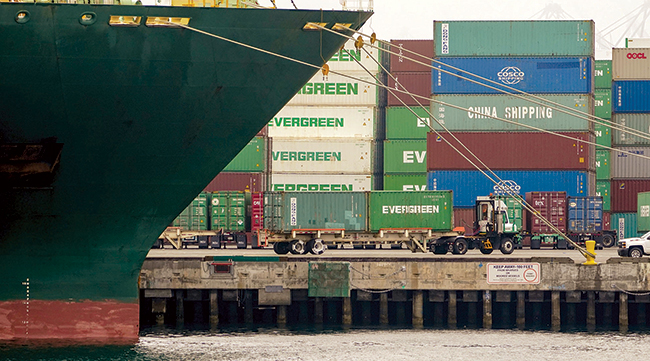
A terminal tractor moves containers at the Port of Los Angeles. (Kyle Grillot/Bloomberg News)
Progress with unsnarling supply chains hasn’t been entirely smooth, and further headwinds are afoot, analysts said.
The Russia-Ukraine war’s disruptions to international supply chains, particularly food and energy, sent costs soaring, especially for fuel.
Meanwhile, China’s zero-COVID policy continues to force city shutdowns, and at the end of the third quarter, Goldman Sachs downgraded its forecast for China’s GDP growth from 3.3% to 3% due to uncertainty over the zero-COVID policy, weak demand and energy concerns.
Worry of another major supply chain upheaval escalated in September due to the threat of a U.S. freight rail strike, but the parties reached a tentative agreement, pending ratification by union workers. Meanwhile, negotiations to avoid a strike at West Coast ports continue.
The largest factor that could alter worldwide freight transport trajectory over the next year is only beginning to materialize: a recession.
“There’s a real risk of a recession in the first half of next year … and that will obviously have an impact on the freight market in terms of volume,” ATA’s Costello said.
Inflation is surging, both in the U.S. and globally, prompting the Federal Reserve to continue its interest rate hikes. Frost & Sullivan’s Gopal R points to forecasts suggesting hikes through mid-2023, which will have a chilling effect on the economy and freight.
“The bounce that we’ve seen recently is not likely sustainable in the U.S. ... and we’ll probably see some softening from here,” ACT’s Denoyer said. “We went through such an extreme couple of years of goods consumption, starting in 2020, and there’s a fair amount of that that still needs to come out of the system.”
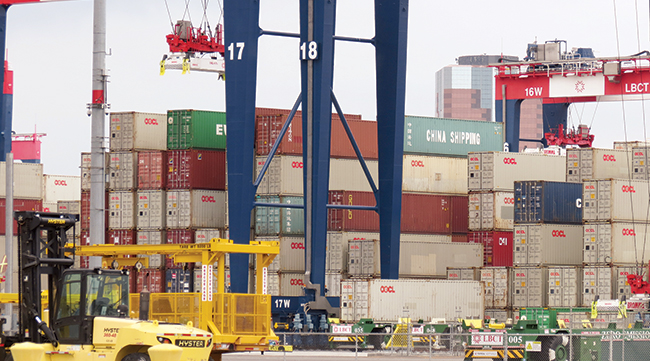
Containers stacked at the Port of Long Beach. (Seth Clevenger/Transport Topics)
Rising costs for fuel, equipment, insurance and driver wages are taking a toll on trucking companies, Costello said, adding that “truck driver is one of the few occupations out there [where pay] is not only keeping up with inflation, but it is exceeding inflation.”
FedEx’s bombshell preliminary third-quarter report detailing a big earnings miss and warning of weak global shipping demand sent shockwaves through the transport world and is widely considered a recession harbinger.
Some analysts are hopeful for a relatively mild downturn. Indicators point to a shallower, shorter recession than the one in 2008, according to Costello. The U.S. economy’s condition generally is decent, which makes the case for a milder recession, Denoyer said, “but it certainly seems like it’s going to get harder before it gets better.”
Many analysts point to a recession beginning in the first quarter of 2023, but waning demand suggests a freight recession might already be underway. However, restocking of retailer holiday goods provides a near-term buoy.
Walmart, for instance, launched a 40,000-employee hiring spree ahead of the holidays, aiming to bring on 1,500 full-time, permanent truck drivers.
“I could assure the public that we’re going to have a very good holiday season. … The shelves will be fine,” the Port of Long Beach’s Cordero said. “So at least for the remainder of 2022, I think we’re looking to some stabilization and normalization in the supply chain.”
Want more news? Listen to today's daily briefing below or go here for more info:


